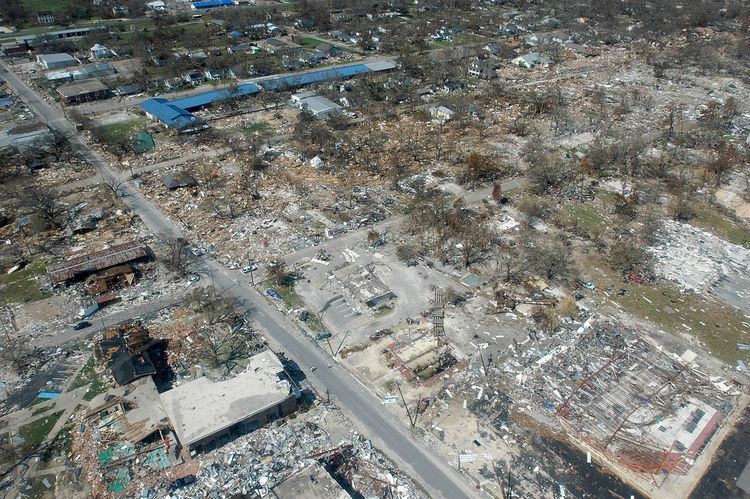 | ||
This is a list of costliest Atlantic hurricanes. Hurricanes, as defined by the National Oceanic and Atmospheric Administration (NOAA), are tropical cyclones—a warm-core, non-frontal synoptic-scale cyclone, originating over tropical or subtropical waters with organized deep convection and a closed surface wind circulation about a well-defined center—in the Atlantic, Caribbean Sea, Gulf of Mexico, or eastern Pacific, in which the maximum 1-minute sustained surface wind exceeds 64 knots (74 mph; 119 km/h) or greater. The hurricanes on the list below depict the severity of the damage the system has caused. Typically, if a hurricane has caused significant damage to a particular location, its name is retired so that it will not be re-used as a name for any future hurricanes. The costliest hurricane ever recorded in the Atlantic was Hurricane Katrina, which struck the coastlines of Mississippi and Louisiana after brushing the tip of Florida, in August 2005, causing $108 billion (2005 USD) in property damage. The most recent, costliest hurricane was Hurricane Matthew, which struck the coastlines of Haiti, Cuba, and eastern United States, causing $15 billion (2016 USD) in damage in September-October 2016.
A majority of the costliest Atlantic hurricanes in recorded history have peaked as major hurricanes. However, weaker tropical cyclones can still cause widespread damage. Both tropical storms Allison in 2001 and Lee in 2011 have caused over a billion in damage; the former of which accounted for a higher damage total. Due to their excessive damage, the names of tropical cyclones accruing over $1 billion in damage are often retired by the World Meteorological Organization. However, this is not always the case. Hurricane Juan in 1985 was the first hurricane to cause over a billion in damage and not be retired; its name was retired on a later usage in 2003 that did not cause over a billion in damage. Since Juan, five tropical cyclones that caused over a billion in damage were not retired, the most recent of which being Hurricane Isaac in 2012. All other 39 Atlantic hurricanes to have caused as much damage have had their names retired.
The first hurricane to cause over $1 billion in damage was Hurricane Betsy in 1965, which caused much of its damage in southeastern Louisiana. Two and four years later, Hurricanes Beulah and Camille both caused at least $1 billion in damage. After the 1960s, each decade saw an increase in tropical cyclones causing at least a billion in damage over the last, due to increasing urban development and population. In the 1970s, four hurricanes caused over a billion in damage; the costliest of which was Hurricane Frederic, which caused $2.3 billion in damage, particularly in Mississippi and Alabama. The following decade featured seven hurricanes causing in excess of a billion in damage. In the 1989 season, Hurricane Hugo was the first storm to hit $10 Billion US dollars in cost. In the 1990s, nine tropical cyclones accrued more than a billion in damage. Hurricane Andrew in 1992 greatly exceeded the damage figure of any preceding tropical cyclone after causing $26.5 billion in damage, mostly in South Florida. Seventeen tropical cyclones in the 2000s caused in excess of $1 billion in damage. Both 2004 and 2005 seasons had five billion-dollar hurricanes apiece, the most of any season on record. Hurricane Ivan caused at least a billion in damage in three separate countries. Thus far in the 2010s, seven storms have caused at least $1 billion in damage.
Overall costliest
This list ranks tropical cyclones within the Atlantic that have accrued at least US$1 billion in damage, based on their uninflated damage totals.
